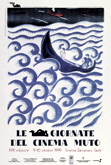
Le Giornate
del Cinema Muto
18th Pordenone
Silent Film Festival
Teatro Zancanaro, Sacile
9 - 16 October 1999
director: David Robinson
Sezioni
/Festival Features
Un trésor dans une armoire
All’inizio di quest’anno, un rigattiere, sgomberando un’antica abitazione, rinveniva nel fondo d’un armadio una cassa contenente 80 Kg di vecchi rulli di film che ha presto venduto a due collezionisti della regione perennemente alla ricerca di vecchi film da proiettare sui propri apparecchi d’epoca. I due collezionisti sono stati costretti a bruciare i rulli ormai irreparabilmente rovinati; le restanti pellicole invece avevano subìto un processo di restringimento particolarmente accentuato che ne impediva la proiezione. A questo punto i due collezionisti si sono rivolti a noi proponendo un baratto: il loro stock di film "improiettabili" in cambio di un certo numero di copie moderne su supporto di sicurezza. Ed è così che ci siamo trovati in possesso di circa novanta film.
Dall’aspetto stesso della pellicola e dai soggetti individuati in trasparenza, ci siamo resi immediatamente conto che il rigattiere aveva scoperto un vero tesoro.
Infatti, la coda iniziale di uno dei primi film esaminati riportava l’impronta a freddo della firma di Georges Méliès seguita dalla caratteristica stella nera della Star Films, oltre a due numeri, il primo dei quali corrisponde al numero di catalogo. Avevamo, dunque, di fronte a noi un film realizzato da Méliès nel 1896, corrispondente al n. 26 del catalogo, il quale, però, indicava una lunghezza di 29 metri mentre il nostro rullo ne misurava 60. Ma la spiegazione è molto semplice: il rullo conteneva tre film, testa a testa, tre film di Georges Méliès!
I 90 film rappresentano una scoperta straordinaria in quanto ricoprono un arco di tempo che va dal 1896 al 1906, con film di Méliès, Pathé, Lumière, Gaumont e alcuni altri (ancora da identificare). Dei ventinove film di Méliès già identificati, diciassette erano considerati perduti, altri esistevano solo nella copia paper print depositata alla Library of Congress di Washington.
Procedendo nel nostro lavoro di identificazione ci siamo subito resi conto che si trattava di una raccolta molto coerente, come se l’acquirente avesse regolarmente rinnovato la sua collezione coi nuovi titoli immessi di volta in volta sul mercato. Il che trova una perfetta rispondenza nelle usuali pratiche di diffusione dei film prima del 1908. Infatti, prima di questa data — che segnò la prima vera strutturazione del mercato della distribuzione — le case di produzione non noleggiavano le copie dei film, bensì le vendevano, soprattutto ai baracconi ambulanti, dove le pellicole acquistate venivano proiettate fino a che non si usuravano per poi procedere al rinnovo dello stock. Il nostro stock non era più stato toccato dal 1905.
Il restauro è stato affidato all’olandese Hagefilm, il miglior laboratorio specializzato nel trattamento e stampa dei materiali estremamente ristretti. Il primo passo è stato quello di ottenere un controtipo negativo su supporto di sicurezza per la conservazione a da qui procedere alla stampa della copia positiva per la proiezione di Sacile.
At the beginning of the year, a dealer clearing an old house found a crate containing 80kg of old films, which he sold to two local collectors who look for films to show on their period projectors. They were at first disappointed. Some of the reels were so decomposed that they had to be thrown away. The rest, they found, had shrunk so badly that they would not go through their projectors — fortunately perhaps: this inconvenient aspect of their deterioration paradoxically may well have saved the films from extinction. Despairing of being able to make any use of them, the collectors called us to arrange an exchange of these "unshowable" films for modern copies on safety stock.
Thus we found ourselves in possession of a group of around 90 films. Merely holding the films up to the light quickly convinced us that this was an exception discovery. On the leader of one of the first reels that we examined was the signature of Georges Méliès and the characteristic logo of his "Star Films" company, as well as two numbers, the first of which corresponded to the original catalogue entry. We were in the presence of a film made by Méliès in 1896. Yet the catalogue indicated that the film measured only 20m, while our reel measured 60m. The explanation was simple: here was not merely one film by Georges Méliès, but three joined end to end. As we explored the find we discovered that the films covered the period 1896 to 1905, with productions by Méliès, Pathé, Lumière, Gaumont, Urban, and other unidentified makers. The thirty Méliès films are particularly exciting. Of the 29 already identified, 17 were considered totally lost, while others existed only in the form of paper prints deposited with the Library or Congress in Washington.
Examining further, we realised that the collection was very coherent — the stock of a showman who had regularly renewed it as new films came on the market. It illustrated the practice before the introduction of film rental about 1908 — the period when exhibitors, often fairground showmen, bought films outright and used them until they fell to pieces and had to be replaced. Here was a stock which had probably not been touched since 1905.
Restoration of the films was entrusted to the Dutch firm of Haghefilm, one of the world’s finest laboratories for the delicate work of rectifying excessively shrunken films. The first task has been to make a duplicate negative on safety stock to ensure the permanent preservation of the films: from these positive prints have been for such presentations as the Sacile screenings.Serge Bromberg, Eric Lange
Tutti i titoli in programma sono indicati nel "Calendario", sezione "Un trésor dans une armoire". / Titles listed in the "Daily Schedule" under "Un trésor dans une armoire".